Case Study Analysis: Crohn's Disease, Symptoms, and Management
VerifiedAdded on 2022/09/10
|8
|1902
|16
Case Study
AI Summary
This case study focuses on Crohn's disease (CD), a chronic inflammatory condition with a complex etiology involving genetic and environmental factors. The assignment delves into the manifestations of CD, including weight loss, malnutrition, and the structural changes associated with intestinal inflammation. It explores the underlying pathophysiology, such as the increased production of cytokines, the impact on gut microbiota, and the involvement of the immune system. The study examines the pain pathways involved, the role of morphine, and the specific symptoms experienced by a patient, including right lower quadrant pain, bloating, and diarrhea. The assignment also addresses the rationale for intravenous fluid administration, specifically Hartman's solution, considering the electrolyte imbalances and dehydration common in CD, and provides relevant references to support the analysis.
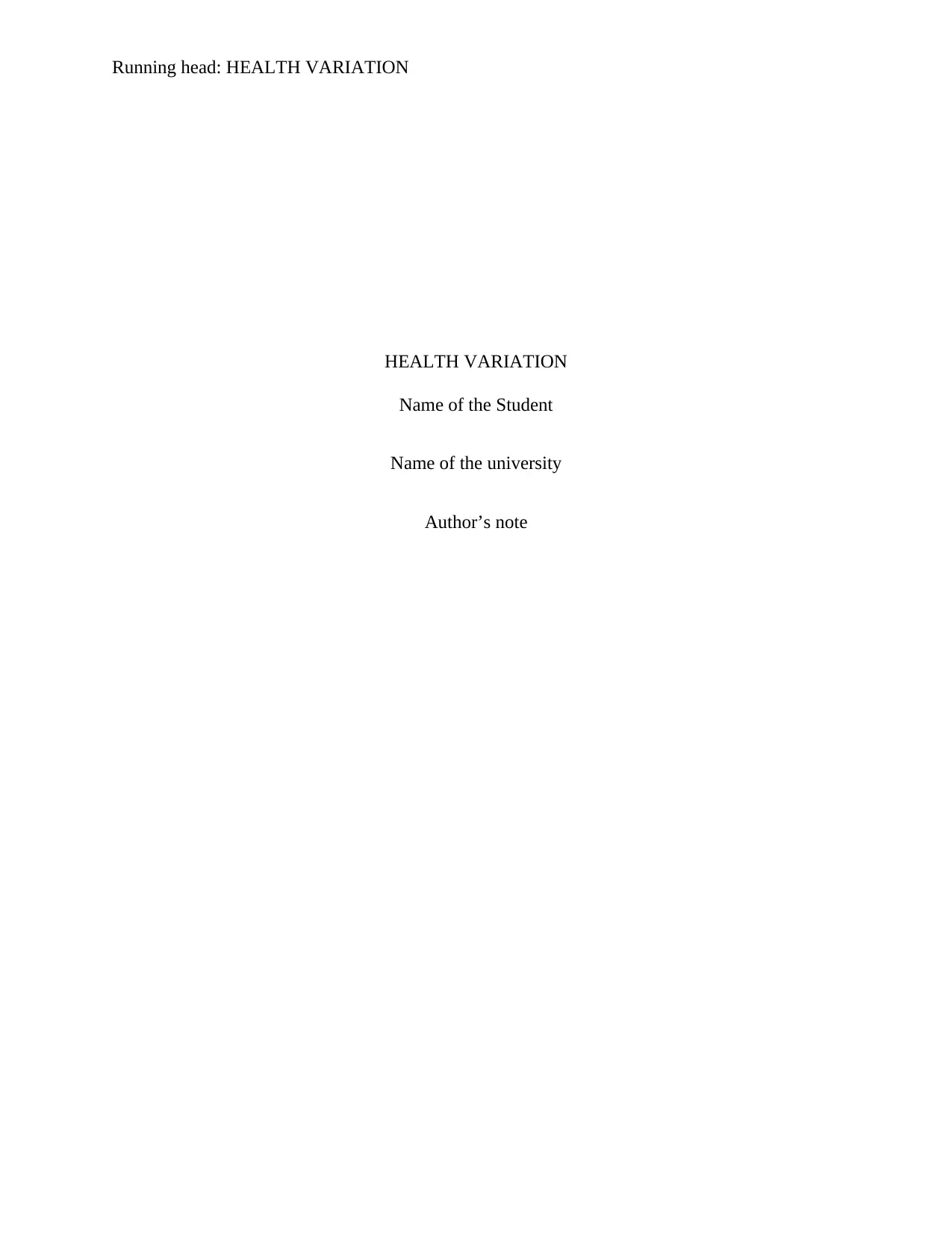
Running head: HEALTH VARIATION
HEALTH VARIATION
Name of the Student
Name of the university
Author’s note
HEALTH VARIATION
Name of the Student
Name of the university
Author’s note
Paraphrase This Document
Need a fresh take? Get an instant paraphrase of this document with our AI Paraphraser
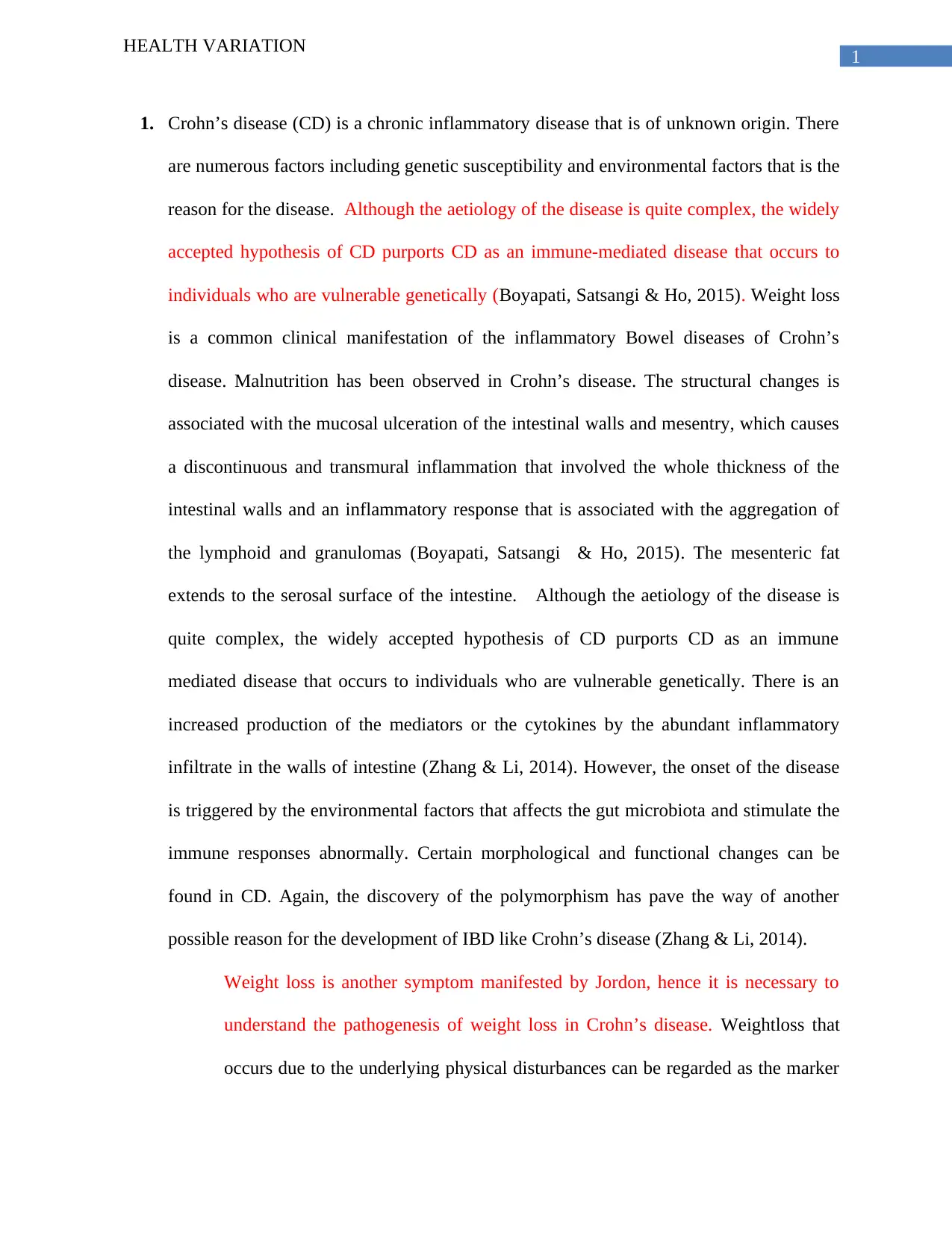
1
HEALTH VARIATION
1. Crohn’s disease (CD) is a chronic inflammatory disease that is of unknown origin. There
are numerous factors including genetic susceptibility and environmental factors that is the
reason for the disease. Although the aetiology of the disease is quite complex, the widely
accepted hypothesis of CD purports CD as an immune-mediated disease that occurs to
individuals who are vulnerable genetically (Boyapati, Satsangi & Ho, 2015). Weight loss
is a common clinical manifestation of the inflammatory Bowel diseases of Crohn’s
disease. Malnutrition has been observed in Crohn’s disease. The structural changes is
associated with the mucosal ulceration of the intestinal walls and mesentry, which causes
a discontinuous and transmural inflammation that involved the whole thickness of the
intestinal walls and an inflammatory response that is associated with the aggregation of
the lymphoid and granulomas (Boyapati, Satsangi & Ho, 2015). The mesenteric fat
extends to the serosal surface of the intestine. Although the aetiology of the disease is
quite complex, the widely accepted hypothesis of CD purports CD as an immune
mediated disease that occurs to individuals who are vulnerable genetically. There is an
increased production of the mediators or the cytokines by the abundant inflammatory
infiltrate in the walls of intestine (Zhang & Li, 2014). However, the onset of the disease
is triggered by the environmental factors that affects the gut microbiota and stimulate the
immune responses abnormally. Certain morphological and functional changes can be
found in CD. Again, the discovery of the polymorphism has pave the way of another
possible reason for the development of IBD like Crohn’s disease (Zhang & Li, 2014).
Weight loss is another symptom manifested by Jordon, hence it is necessary to
understand the pathogenesis of weight loss in Crohn’s disease. Weightloss that
occurs due to the underlying physical disturbances can be regarded as the marker
HEALTH VARIATION
1. Crohn’s disease (CD) is a chronic inflammatory disease that is of unknown origin. There
are numerous factors including genetic susceptibility and environmental factors that is the
reason for the disease. Although the aetiology of the disease is quite complex, the widely
accepted hypothesis of CD purports CD as an immune-mediated disease that occurs to
individuals who are vulnerable genetically (Boyapati, Satsangi & Ho, 2015). Weight loss
is a common clinical manifestation of the inflammatory Bowel diseases of Crohn’s
disease. Malnutrition has been observed in Crohn’s disease. The structural changes is
associated with the mucosal ulceration of the intestinal walls and mesentry, which causes
a discontinuous and transmural inflammation that involved the whole thickness of the
intestinal walls and an inflammatory response that is associated with the aggregation of
the lymphoid and granulomas (Boyapati, Satsangi & Ho, 2015). The mesenteric fat
extends to the serosal surface of the intestine. Although the aetiology of the disease is
quite complex, the widely accepted hypothesis of CD purports CD as an immune
mediated disease that occurs to individuals who are vulnerable genetically. There is an
increased production of the mediators or the cytokines by the abundant inflammatory
infiltrate in the walls of intestine (Zhang & Li, 2014). However, the onset of the disease
is triggered by the environmental factors that affects the gut microbiota and stimulate the
immune responses abnormally. Certain morphological and functional changes can be
found in CD. Again, the discovery of the polymorphism has pave the way of another
possible reason for the development of IBD like Crohn’s disease (Zhang & Li, 2014).
Weight loss is another symptom manifested by Jordon, hence it is necessary to
understand the pathogenesis of weight loss in Crohn’s disease. Weightloss that
occurs due to the underlying physical disturbances can be regarded as the marker
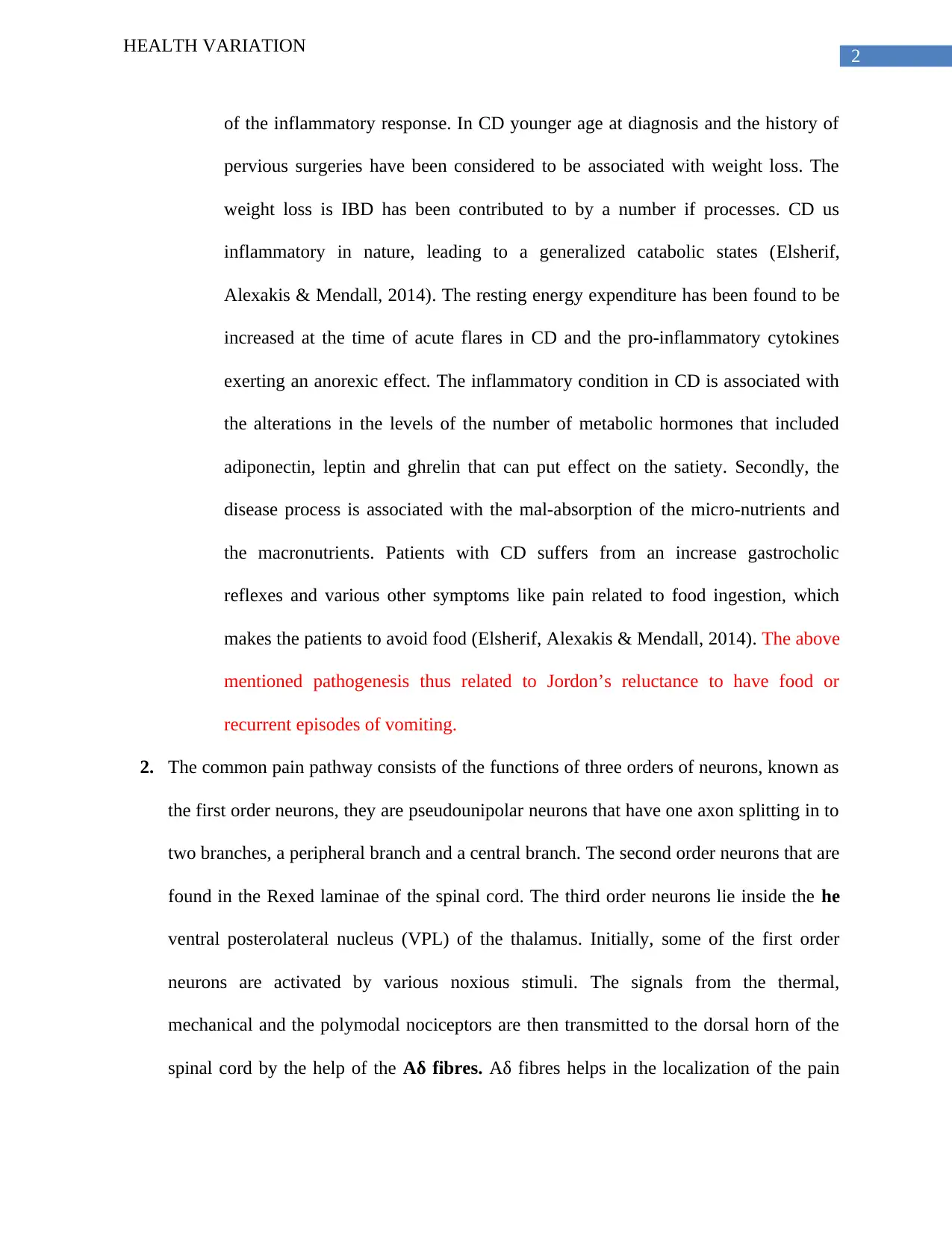
2
HEALTH VARIATION
of the inflammatory response. In CD younger age at diagnosis and the history of
pervious surgeries have been considered to be associated with weight loss. The
weight loss is IBD has been contributed to by a number if processes. CD us
inflammatory in nature, leading to a generalized catabolic states (Elsherif,
Alexakis & Mendall, 2014). The resting energy expenditure has been found to be
increased at the time of acute flares in CD and the pro-inflammatory cytokines
exerting an anorexic effect. The inflammatory condition in CD is associated with
the alterations in the levels of the number of metabolic hormones that included
adiponectin, leptin and ghrelin that can put effect on the satiety. Secondly, the
disease process is associated with the mal-absorption of the micro-nutrients and
the macronutrients. Patients with CD suffers from an increase gastrocholic
reflexes and various other symptoms like pain related to food ingestion, which
makes the patients to avoid food (Elsherif, Alexakis & Mendall, 2014). The above
mentioned pathogenesis thus related to Jordon’s reluctance to have food or
recurrent episodes of vomiting.
2. The common pain pathway consists of the functions of three orders of neurons, known as
the first order neurons, they are pseudounipolar neurons that have one axon splitting in to
two branches, a peripheral branch and a central branch. The second order neurons that are
found in the Rexed laminae of the spinal cord. The third order neurons lie inside the he
ventral posterolateral nucleus (VPL) of the thalamus. Initially, some of the first order
neurons are activated by various noxious stimuli. The signals from the thermal,
mechanical and the polymodal nociceptors are then transmitted to the dorsal horn of the
spinal cord by the help of the Aδ fibres. Aδ fibres helps in the localization of the pain
HEALTH VARIATION
of the inflammatory response. In CD younger age at diagnosis and the history of
pervious surgeries have been considered to be associated with weight loss. The
weight loss is IBD has been contributed to by a number if processes. CD us
inflammatory in nature, leading to a generalized catabolic states (Elsherif,
Alexakis & Mendall, 2014). The resting energy expenditure has been found to be
increased at the time of acute flares in CD and the pro-inflammatory cytokines
exerting an anorexic effect. The inflammatory condition in CD is associated with
the alterations in the levels of the number of metabolic hormones that included
adiponectin, leptin and ghrelin that can put effect on the satiety. Secondly, the
disease process is associated with the mal-absorption of the micro-nutrients and
the macronutrients. Patients with CD suffers from an increase gastrocholic
reflexes and various other symptoms like pain related to food ingestion, which
makes the patients to avoid food (Elsherif, Alexakis & Mendall, 2014). The above
mentioned pathogenesis thus related to Jordon’s reluctance to have food or
recurrent episodes of vomiting.
2. The common pain pathway consists of the functions of three orders of neurons, known as
the first order neurons, they are pseudounipolar neurons that have one axon splitting in to
two branches, a peripheral branch and a central branch. The second order neurons that are
found in the Rexed laminae of the spinal cord. The third order neurons lie inside the he
ventral posterolateral nucleus (VPL) of the thalamus. Initially, some of the first order
neurons are activated by various noxious stimuli. The signals from the thermal,
mechanical and the polymodal nociceptors are then transmitted to the dorsal horn of the
spinal cord by the help of the Aδ fibres. Aδ fibres helps in the localization of the pain
⊘ This is a preview!⊘
Do you want full access?
Subscribe today to unlock all pages.

Trusted by 1+ million students worldwide
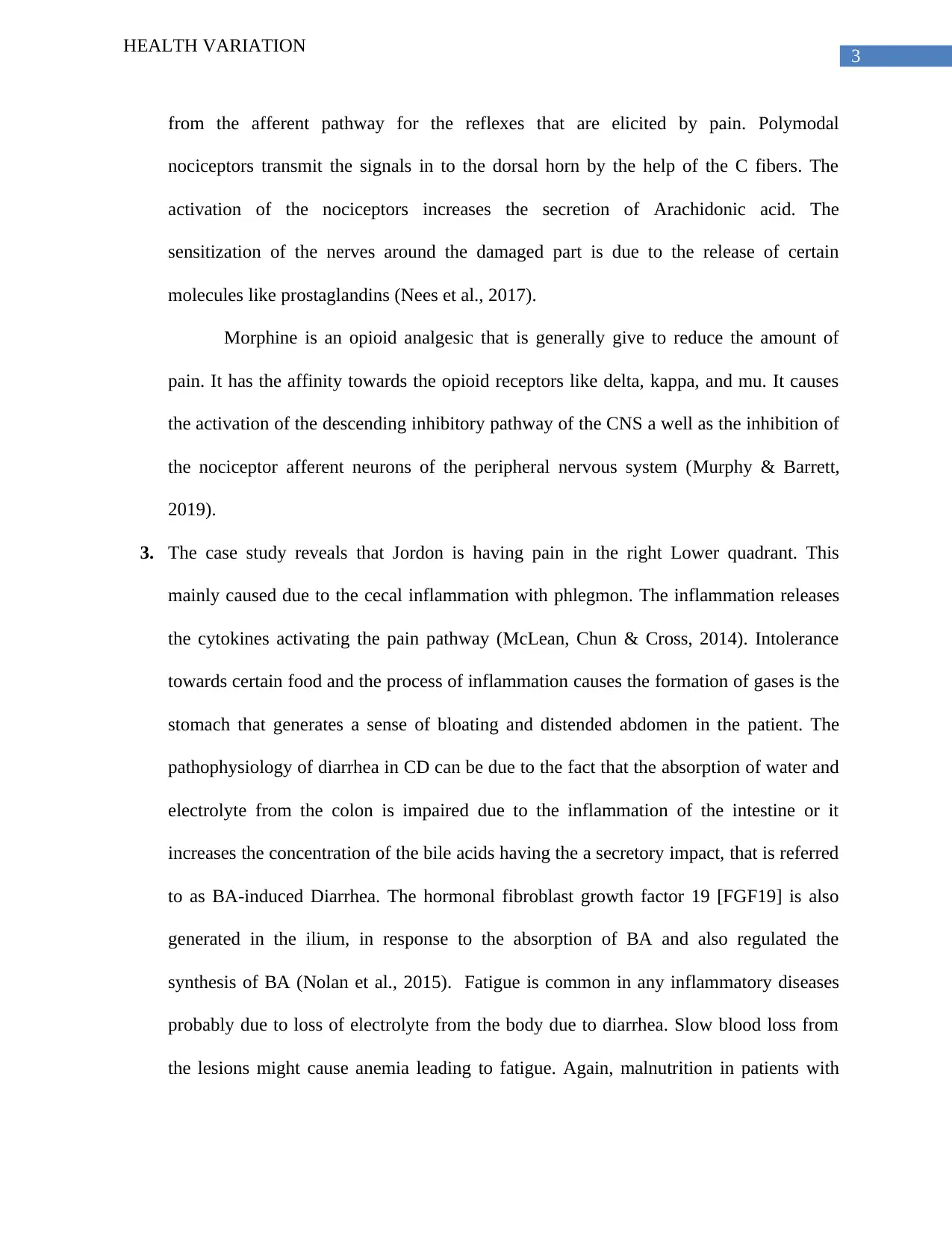
3
HEALTH VARIATION
from the afferent pathway for the reflexes that are elicited by pain. Polymodal
nociceptors transmit the signals in to the dorsal horn by the help of the C fibers. The
activation of the nociceptors increases the secretion of Arachidonic acid. The
sensitization of the nerves around the damaged part is due to the release of certain
molecules like prostaglandins (Nees et al., 2017).
Morphine is an opioid analgesic that is generally give to reduce the amount of
pain. It has the affinity towards the opioid receptors like delta, kappa, and mu. It causes
the activation of the descending inhibitory pathway of the CNS a well as the inhibition of
the nociceptor afferent neurons of the peripheral nervous system (Murphy & Barrett,
2019).
3. The case study reveals that Jordon is having pain in the right Lower quadrant. This
mainly caused due to the cecal inflammation with phlegmon. The inflammation releases
the cytokines activating the pain pathway (McLean, Chun & Cross, 2014). Intolerance
towards certain food and the process of inflammation causes the formation of gases is the
stomach that generates a sense of bloating and distended abdomen in the patient. The
pathophysiology of diarrhea in CD can be due to the fact that the absorption of water and
electrolyte from the colon is impaired due to the inflammation of the intestine or it
increases the concentration of the bile acids having the a secretory impact, that is referred
to as BA-induced Diarrhea. The hormonal fibroblast growth factor 19 [FGF19] is also
generated in the ilium, in response to the absorption of BA and also regulated the
synthesis of BA (Nolan et al., 2015). Fatigue is common in any inflammatory diseases
probably due to loss of electrolyte from the body due to diarrhea. Slow blood loss from
the lesions might cause anemia leading to fatigue. Again, malnutrition in patients with
HEALTH VARIATION
from the afferent pathway for the reflexes that are elicited by pain. Polymodal
nociceptors transmit the signals in to the dorsal horn by the help of the C fibers. The
activation of the nociceptors increases the secretion of Arachidonic acid. The
sensitization of the nerves around the damaged part is due to the release of certain
molecules like prostaglandins (Nees et al., 2017).
Morphine is an opioid analgesic that is generally give to reduce the amount of
pain. It has the affinity towards the opioid receptors like delta, kappa, and mu. It causes
the activation of the descending inhibitory pathway of the CNS a well as the inhibition of
the nociceptor afferent neurons of the peripheral nervous system (Murphy & Barrett,
2019).
3. The case study reveals that Jordon is having pain in the right Lower quadrant. This
mainly caused due to the cecal inflammation with phlegmon. The inflammation releases
the cytokines activating the pain pathway (McLean, Chun & Cross, 2014). Intolerance
towards certain food and the process of inflammation causes the formation of gases is the
stomach that generates a sense of bloating and distended abdomen in the patient. The
pathophysiology of diarrhea in CD can be due to the fact that the absorption of water and
electrolyte from the colon is impaired due to the inflammation of the intestine or it
increases the concentration of the bile acids having the a secretory impact, that is referred
to as BA-induced Diarrhea. The hormonal fibroblast growth factor 19 [FGF19] is also
generated in the ilium, in response to the absorption of BA and also regulated the
synthesis of BA (Nolan et al., 2015). Fatigue is common in any inflammatory diseases
probably due to loss of electrolyte from the body due to diarrhea. Slow blood loss from
the lesions might cause anemia leading to fatigue. Again, malnutrition in patients with
Paraphrase This Document
Need a fresh take? Get an instant paraphrase of this document with our AI Paraphraser
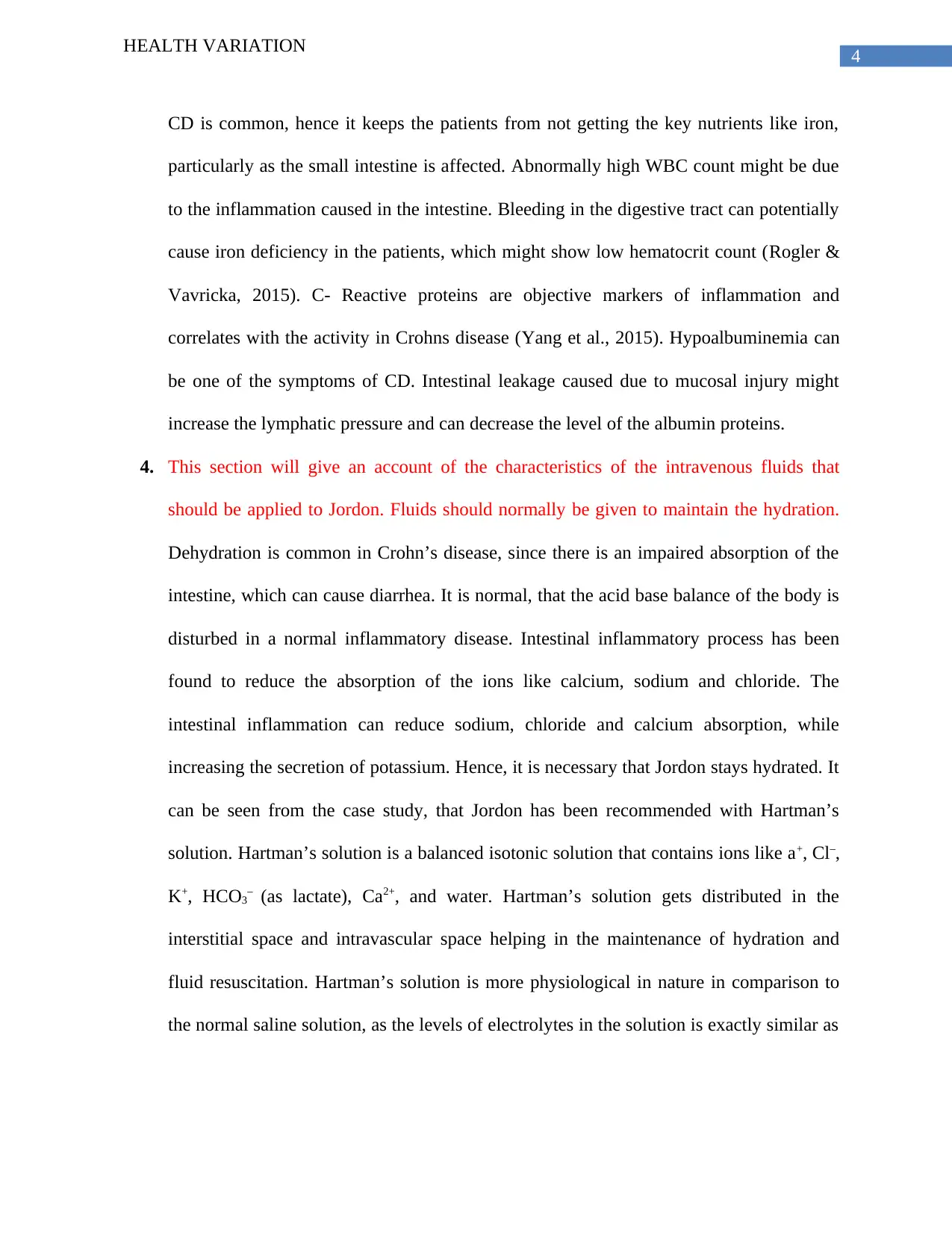
4
HEALTH VARIATION
CD is common, hence it keeps the patients from not getting the key nutrients like iron,
particularly as the small intestine is affected. Abnormally high WBC count might be due
to the inflammation caused in the intestine. Bleeding in the digestive tract can potentially
cause iron deficiency in the patients, which might show low hematocrit count (Rogler &
Vavricka, 2015). C- Reactive proteins are objective markers of inflammation and
correlates with the activity in Crohns disease (Yang et al., 2015). Hypoalbuminemia can
be one of the symptoms of CD. Intestinal leakage caused due to mucosal injury might
increase the lymphatic pressure and can decrease the level of the albumin proteins.
4. This section will give an account of the characteristics of the intravenous fluids that
should be applied to Jordon. Fluids should normally be given to maintain the hydration.
Dehydration is common in Crohn’s disease, since there is an impaired absorption of the
intestine, which can cause diarrhea. It is normal, that the acid base balance of the body is
disturbed in a normal inflammatory disease. Intestinal inflammatory process has been
found to reduce the absorption of the ions like calcium, sodium and chloride. The
intestinal inflammation can reduce sodium, chloride and calcium absorption, while
increasing the secretion of potassium. Hence, it is necessary that Jordon stays hydrated. It
can be seen from the case study, that Jordon has been recommended with Hartman’s
solution. Hartman’s solution is a balanced isotonic solution that contains ions like a+, Cl–,
K+, HCO3– (as lactate), Ca2+, and water. Hartman’s solution gets distributed in the
interstitial space and intravascular space helping in the maintenance of hydration and
fluid resuscitation. Hartman’s solution is more physiological in nature in comparison to
the normal saline solution, as the levels of electrolytes in the solution is exactly similar as
HEALTH VARIATION
CD is common, hence it keeps the patients from not getting the key nutrients like iron,
particularly as the small intestine is affected. Abnormally high WBC count might be due
to the inflammation caused in the intestine. Bleeding in the digestive tract can potentially
cause iron deficiency in the patients, which might show low hematocrit count (Rogler &
Vavricka, 2015). C- Reactive proteins are objective markers of inflammation and
correlates with the activity in Crohns disease (Yang et al., 2015). Hypoalbuminemia can
be one of the symptoms of CD. Intestinal leakage caused due to mucosal injury might
increase the lymphatic pressure and can decrease the level of the albumin proteins.
4. This section will give an account of the characteristics of the intravenous fluids that
should be applied to Jordon. Fluids should normally be given to maintain the hydration.
Dehydration is common in Crohn’s disease, since there is an impaired absorption of the
intestine, which can cause diarrhea. It is normal, that the acid base balance of the body is
disturbed in a normal inflammatory disease. Intestinal inflammatory process has been
found to reduce the absorption of the ions like calcium, sodium and chloride. The
intestinal inflammation can reduce sodium, chloride and calcium absorption, while
increasing the secretion of potassium. Hence, it is necessary that Jordon stays hydrated. It
can be seen from the case study, that Jordon has been recommended with Hartman’s
solution. Hartman’s solution is a balanced isotonic solution that contains ions like a+, Cl–,
K+, HCO3– (as lactate), Ca2+, and water. Hartman’s solution gets distributed in the
interstitial space and intravascular space helping in the maintenance of hydration and
fluid resuscitation. Hartman’s solution is more physiological in nature in comparison to
the normal saline solution, as the levels of electrolytes in the solution is exactly similar as

5
HEALTH VARIATION
present in plasma. Hartman’s solution also contains lactate, that is used for the
generation of the alkalizing ions.
HEALTH VARIATION
present in plasma. Hartman’s solution also contains lactate, that is used for the
generation of the alkalizing ions.
⊘ This is a preview!⊘
Do you want full access?
Subscribe today to unlock all pages.

Trusted by 1+ million students worldwide
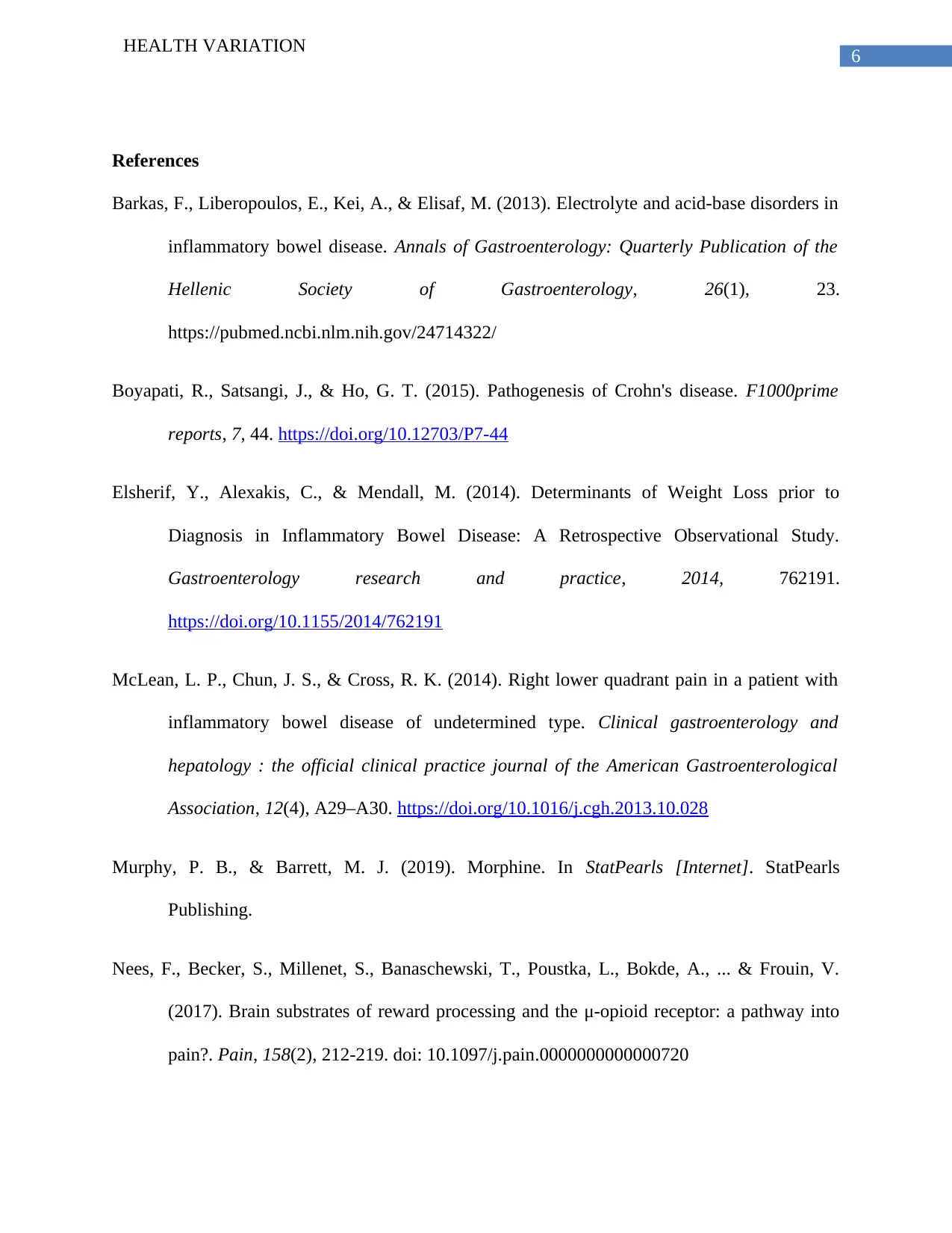
6
HEALTH VARIATION
References
Barkas, F., Liberopoulos, E., Kei, A., & Elisaf, M. (2013). Electrolyte and acid-base disorders in
inflammatory bowel disease. Annals of Gastroenterology: Quarterly Publication of the
Hellenic Society of Gastroenterology, 26(1), 23.
https://pubmed.ncbi.nlm.nih.gov/24714322/
Boyapati, R., Satsangi, J., & Ho, G. T. (2015). Pathogenesis of Crohn's disease. F1000prime
reports, 7, 44. https://doi.org/10.12703/P7-44
Elsherif, Y., Alexakis, C., & Mendall, M. (2014). Determinants of Weight Loss prior to
Diagnosis in Inflammatory Bowel Disease: A Retrospective Observational Study.
Gastroenterology research and practice, 2014, 762191.
https://doi.org/10.1155/2014/762191
McLean, L. P., Chun, J. S., & Cross, R. K. (2014). Right lower quadrant pain in a patient with
inflammatory bowel disease of undetermined type. Clinical gastroenterology and
hepatology : the official clinical practice journal of the American Gastroenterological
Association, 12(4), A29–A30. https://doi.org/10.1016/j.cgh.2013.10.028
Murphy, P. B., & Barrett, M. J. (2019). Morphine. In StatPearls [Internet]. StatPearls
Publishing.
Nees, F., Becker, S., Millenet, S., Banaschewski, T., Poustka, L., Bokde, A., ... & Frouin, V.
(2017). Brain substrates of reward processing and the μ-opioid receptor: a pathway into
pain?. Pain, 158(2), 212-219. doi: 10.1097/j.pain.0000000000000720
HEALTH VARIATION
References
Barkas, F., Liberopoulos, E., Kei, A., & Elisaf, M. (2013). Electrolyte and acid-base disorders in
inflammatory bowel disease. Annals of Gastroenterology: Quarterly Publication of the
Hellenic Society of Gastroenterology, 26(1), 23.
https://pubmed.ncbi.nlm.nih.gov/24714322/
Boyapati, R., Satsangi, J., & Ho, G. T. (2015). Pathogenesis of Crohn's disease. F1000prime
reports, 7, 44. https://doi.org/10.12703/P7-44
Elsherif, Y., Alexakis, C., & Mendall, M. (2014). Determinants of Weight Loss prior to
Diagnosis in Inflammatory Bowel Disease: A Retrospective Observational Study.
Gastroenterology research and practice, 2014, 762191.
https://doi.org/10.1155/2014/762191
McLean, L. P., Chun, J. S., & Cross, R. K. (2014). Right lower quadrant pain in a patient with
inflammatory bowel disease of undetermined type. Clinical gastroenterology and
hepatology : the official clinical practice journal of the American Gastroenterological
Association, 12(4), A29–A30. https://doi.org/10.1016/j.cgh.2013.10.028
Murphy, P. B., & Barrett, M. J. (2019). Morphine. In StatPearls [Internet]. StatPearls
Publishing.
Nees, F., Becker, S., Millenet, S., Banaschewski, T., Poustka, L., Bokde, A., ... & Frouin, V.
(2017). Brain substrates of reward processing and the μ-opioid receptor: a pathway into
pain?. Pain, 158(2), 212-219. doi: 10.1097/j.pain.0000000000000720
Paraphrase This Document
Need a fresh take? Get an instant paraphrase of this document with our AI Paraphraser
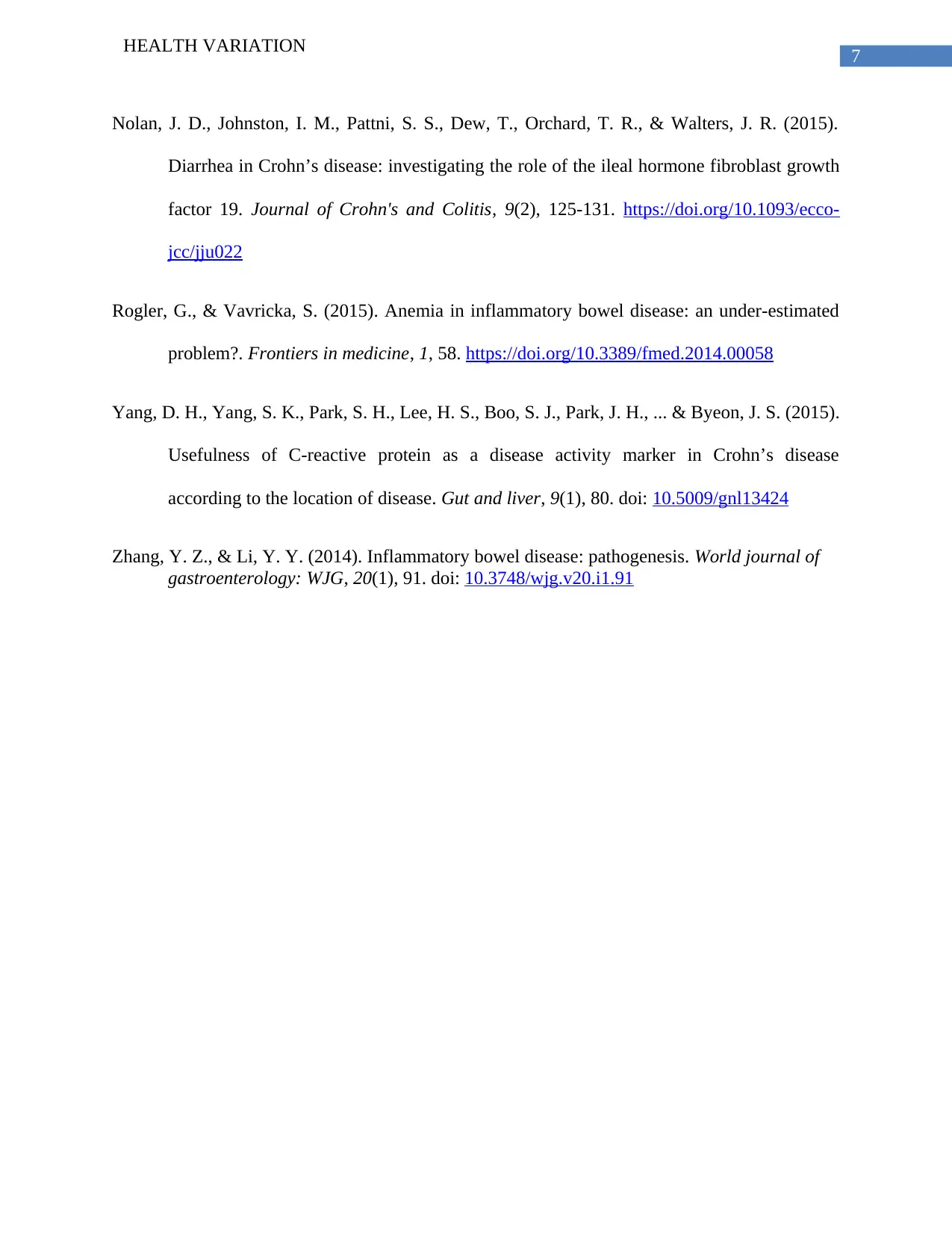
7
HEALTH VARIATION
Nolan, J. D., Johnston, I. M., Pattni, S. S., Dew, T., Orchard, T. R., & Walters, J. R. (2015).
Diarrhea in Crohn’s disease: investigating the role of the ileal hormone fibroblast growth
factor 19. Journal of Crohn's and Colitis, 9(2), 125-131. https://doi.org/10.1093/ecco-
jcc/jju022
Rogler, G., & Vavricka, S. (2015). Anemia in inflammatory bowel disease: an under-estimated
problem?. Frontiers in medicine, 1, 58. https://doi.org/10.3389/fmed.2014.00058
Yang, D. H., Yang, S. K., Park, S. H., Lee, H. S., Boo, S. J., Park, J. H., ... & Byeon, J. S. (2015).
Usefulness of C-reactive protein as a disease activity marker in Crohn’s disease
according to the location of disease. Gut and liver, 9(1), 80. doi: 10.5009/gnl13424
Zhang, Y. Z., & Li, Y. Y. (2014). Inflammatory bowel disease: pathogenesis. World journal of
gastroenterology: WJG, 20(1), 91. doi: 10.3748/wjg.v20.i1.91
HEALTH VARIATION
Nolan, J. D., Johnston, I. M., Pattni, S. S., Dew, T., Orchard, T. R., & Walters, J. R. (2015).
Diarrhea in Crohn’s disease: investigating the role of the ileal hormone fibroblast growth
factor 19. Journal of Crohn's and Colitis, 9(2), 125-131. https://doi.org/10.1093/ecco-
jcc/jju022
Rogler, G., & Vavricka, S. (2015). Anemia in inflammatory bowel disease: an under-estimated
problem?. Frontiers in medicine, 1, 58. https://doi.org/10.3389/fmed.2014.00058
Yang, D. H., Yang, S. K., Park, S. H., Lee, H. S., Boo, S. J., Park, J. H., ... & Byeon, J. S. (2015).
Usefulness of C-reactive protein as a disease activity marker in Crohn’s disease
according to the location of disease. Gut and liver, 9(1), 80. doi: 10.5009/gnl13424
Zhang, Y. Z., & Li, Y. Y. (2014). Inflammatory bowel disease: pathogenesis. World journal of
gastroenterology: WJG, 20(1), 91. doi: 10.3748/wjg.v20.i1.91
1 out of 8
Your All-in-One AI-Powered Toolkit for Academic Success.
+13062052269
info@desklib.com
Available 24*7 on WhatsApp / Email
![[object Object]](/_next/static/media/star-bottom.7253800d.svg)
Unlock your academic potential
Copyright © 2020–2025 A2Z Services. All Rights Reserved. Developed and managed by ZUCOL.

